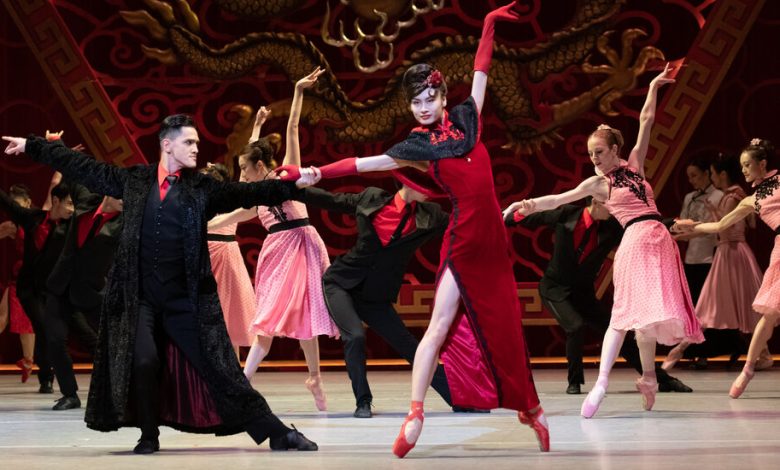Review: Romeo and Juliet Leap to 1960s Hong Kong

In Hong Kong Ballet’s version of “Romeo and Juliet,” a little time travel is necessary. Shakespeare’s tale is set, not in Renaissance Italy, but in 1960s Hong Kong — an era of economic development, of a rising younger generation and of cinema. Hong Kong’s movie culture makes a cameo in this “Romeo,” in which you see, milling around the marketplace, tourists, office workers and a film crew hard at work.
The vaudevillian scene performed as part of that shoot seems incongruous, but there you have it: In this ballet, it’s the small, odd details that stand out. What is absent in the big picture, unfortunately, is vulnerability. Romeo and Juliet lock eyes. They embrace. But there’s little actual feeling.
For the first half of the production, choreographed by the company’s artistic director, Septime Webre (formerly of the Washington Ballet), and performed at New York City Center over the weekend, many members of the audience became amateur filmmakers themselves. It’s true that the colorful show had obvious Instagram appeal, but when a woman held her smartphone high above her head to better shoot the ballroom scene, flash on, the experience started to veer into surreal.
As for the ballet itself? Despite its new setting, this “Romeo” was more ponderous and rushed — yes, both! — than groundbreaking or romantic. Several names of characters have been changed: Tybalt is Tai Po (Garry Corpuz), a triad boss who is Lord Capulet’s associate and, no doubt about it, Lady Capulet’s lover, while the lively Mercutio is Little Mak (Leung Chunlong). Silly and vivacious, he is always quick to bestow a kiss — especially on Tai Po. The premise seems to be that Mak wants to embarrass Tai Po, slick and sinister in black leather, in public, but Mak seems to have a thing for Romeo, too. His last move, after he is stabbed by Tai Po, is to swoon slowly backward into Romeo’s arms and kiss him with a dying man’s gusto.
Even with shifts in characterization, the story remains pretty much the same. Romeo and Juliet come from rival families, they fall in love and they die. The main departure in Webre’s “Romeo” has to do, not just with its sometimes swinging ’60s look, but its fight scenes, which draw on Hong Kong-style kung fu. (The martial arts adviser is Hing Chao.) There are weapons — sticks and butterfly knives — along with physical combat: darting side kicks give way to anemic, theatrical punches.
The design is more absorbing. The set, by Ricky Chan, is alight with neon signs advertising teahouses and nightclubs, and the costumes, by Mandy Tam, are impeccably cut and a mix of sleek 1960s garb and traditional clothing. With patterns and color, slits and collars, Tam’s costumes are the most vibrant and intricate part of the show and often do a better job of telling the story than the choreography does.
Romeo’s world is joyful, ebullient, a land of happy purples and greens, while Juliet’s is largely red and black — harsh, oppressive, dangerous. When Romeo, Mak and Benny (Jonathan Spigner as Webre’s Benvolio) burst into the scene of a gala dinner, the moment Romeo meets Juliet, it’s as if three preppies got lost on their way to the country club and ended up in Dracula’s castle.
On Friday, as Juliet, Ye Feifei was refined yet often too grown up, too distant; Alejandro Virelles, a principal guest artist as Romeo, seemed distracted by Romeo’s choreographic palette, which featured a hectic array of lifts. By the time he made it to the crypt scene, his exhaustion, you sensed, was real.
But most jarring was the way their dancing was strung together with pauses — tiny moments to acknowledge the audience, which continued with others as well. It broke the magic. “Romeo and Juliet” calls for an intimacy so intense that it’s like we, in the crowd, are peeking through the smallest crack of a door. We know what’s going to happen but we can’t help ourselves: We can’t look away.
In this production, occasions for intimacy were continually broken. Why would Romeo turn to pick up his coat before Juliet climbed the balcony stairs? Wouldn’t he want to gaze at her as long as he could? The staircase, with steps on either side — affixed in front with crisscrossing pieces of bamboo, like scaffolding — seemed treacherous enough. During her ascent, a masked stagehand could be seen helping her up. The ballet was a tight fit, much too large for City Center’s stage, and in certain instances, the action in the wings inevitably trickled onto the stage.
Crowded scenes turned into a melee, while the more intimate moments, like when the lovers were alone onstage, turned comical — Romeo would look for Juliet, and Juliet would look for Romeo as they used make-believe blinders while racing across the stage to pause, staring dreamily into corners with imploring arms. It was hard to find flow in the dancing itself, which seemed to prize poses and, always, extension over continuous movement. Hong Kong Ballet had energy, but as for texture? That was left to the costumes.
